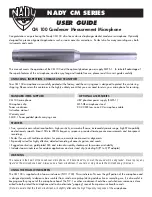
KEEP THE MICROPHONE CLOSE
TO THE DESIRED SOURCE
[2]
TO REDUCE FEEDBACK,
AIM MIC WITH CARDIOID
POLAR PATTERN
(SHADED)
AWAY FROM
LOUDSPEAKERS
[1]
MICROPHONE PICKUP
PATTERN (CARDIOID)
AMPLIFIER
PICKUP (POLAR) PATTERN
ÁÁÁÁÁÁÁÁÁÁÁÁ
ÁÁÁÁÁÁÁÁÁÁÁÁ
ÁÁÁÁÁÁÁÁÁÁÁÁ
ÁÁÁÁÁÁÁÁÁÁÁÁ
ÁÁÁÁÁÁÁÁÁÁÁÁ
ÁÁÁÁÁÁÁÁÁÁÁÁ
ÁÁÁÁÁÁÁÁÁÁÁÁ
Á
Á
Á
Á
Á
Á
Á
Á
Á
Á
Á
Á
Á
Á
Á
Á
Á
Á
Á
Á
Á
Á
Á
Á
Á
Á
Á
Á
Á
Á
Á
Á
Á
Á
Á
Á
Á
Á
Á
Á
Á
Á
Á
Á
Á
Á
Á
Á
Á
Á
Á
Á
Á
Á
Á
Á
Á
Á
Á
Á
Á
Á
Á
Á
Á
Á
Á
Á
Á
Á
Á
Á
Á
Á
Á
Á
Á
Á
ÁÁÁÁÁÁÁÁÁÁÁÁ
ÁÁÁÁÁÁÁÁÁÁÁÁ
Á
Á
Á
Á
Á
Á
Á
Á
Á
Á
Á
Á
Á
Á
Á
Á
Á
Á
Á
Á
Á
Á
Á
Á
Á
Á
Á
Á
Á
Á
Á
Á
Á
Á
Á
Á
Á
Á
Á
Á
Á
Á
Á
Á
Á
Á
Á
Á
Á
Á
Á
Á
Á
Á
TYPICAL FREQUENCY RESPONSE
[3]
[2]
DESCRIPTION
The Model 16A microphone can be used in sound reinforcement or re-
cording, to pick up voices or instruments.
Features
•
Smooth, extended frequency response provides intelligibility and crisp-
ness of sound
•
High output condenser cartridge for highest fidelity
•
Cardioid (unidirectional) pickup pattern suppresses feedback
•
Internal battery power and On/Off switch
BASIC RULES FOR MICROPHONE USE
1.
Aim a directional microphone toward the desired sound source (for
instance, musical instrument, talker, singer) and away from undesired
sources (such as loudspeakers or another instrument) [Figure 1].
2.
Locate the microphone as close as practical to the desired sound
source [Figure 2] for best gain before feedback.
3.
Do not pick up the same sound source with more than one micro-
phone. Keep the distance between multiple microphones at least three
times the distance from each source to its intended microphone.
4.
Use the fewest microphones possible for the particular application.
5.
When extra bass response is desirable, work close to the microphone.
This phenomenon is known as “proximity effect”.
6.
Locate microphones as far as possible from acoustically reflective
(hard, smooth) surfaces.
7.
Add an external windscreen when additional pop protection is needed:
outdoors in windy conditions or for closeup vocal use.
8.
To preserve directional characteristics, do not obstruct the microphone
grille.
SPECIFICATIONS
Type
Condenser (electret bias)
Frequency Response
50 to 15,000 Hz (see [3])
Pickup (Polar) Pattern
Cardioid (unidirectional) (see [4])
Impedance (Z)
Low (600
Ω
balanced)
Output Level (at 1 kHz)
Open Circuit Voltage: –68.0 dB (0.40 mV) *
*0 dB = 1 V/
µ
bar
Maximum SPL (at 1 kHz)
120 dB
Polarity
Positive pressure on diaphragm produces positive voltage on pin 2
with respect to pin 3.
Battery Type
1.5 volt “AA”, more than 1,000 hours battery life (alkaline battery). To
replace battery, unscrew and remove cartridge (top portion), replace
the old battery with a new battery making sure the positive end is facing
the cartridge, then screw the cartridge back on.
Connector
Three-pin professional audio connector (male XLR)
Switch
On/Off switch.
Weight:127 g (4.5 oz)
Certifications
Conforms to European Union directives, eligible to bear CE marking;
meets European Union EMC Emissions and Immunity Requirements
(EN 50081–1: 1992, EN 50082–1: 1992).
VARIATION
16AM
Swivel Adapter, Storage Bag
. . . . . . . . . . . . . . . . . . . . . . . . . . . . . . . .
OPTIONAL ACCESSORIES
4.57 m (15 ft.) Cable (XLR-
1
/
4
in.)
C15HZ
. . . . . . . . . . . . . . . . . . . . . . . . . . .
6.1 m (20 ft.) Cable (XLR-
1
/
4
in.)
C20HZ
. . . . . . . . . . . . . . . . . . . . . . . . . . . .
7.6 m (25 ft.) Cable (XLR-XLR)
C25J
. . . . . . . . . . . . . . . . . . . . . . . . . . . . . . .
Windscreen
A4WS
. . . . . . . . . . . . . . . . . . . . . . . . . . . . . . . . . . . . . . . . . . . . . . .
REPLACEMENT PARTS
Cartridge and Housing Assembly
R16
. . . . . . . . . . . . . . . . . . . . . . . . . . . . . .
Screen and Grille Assembly
RK16PG
. . . . . . . . . . . . . . . . . . . . . . . . . . . . . .
Swivel Adapter
RK251
. . . . . . . . . . . . . . . . . . . . . . . . . . . . . . . . . . . . . . . . . . .
For additional service or parts information, please contact Shure’s
Service department at 1-800-516-2525. Outside the United States, please
contact your authorized Shure Service Center.
Model 16A User Guide
27B3096 (AB)
2001, Shure Incorporated
Printed in U.S.A.






















